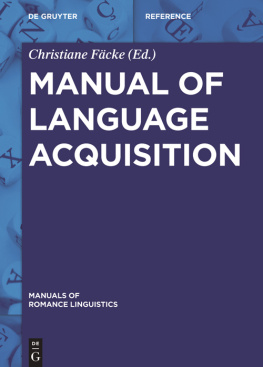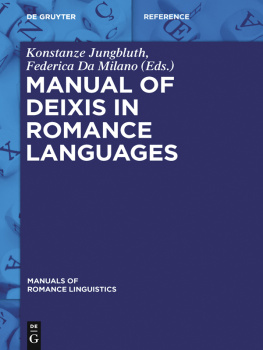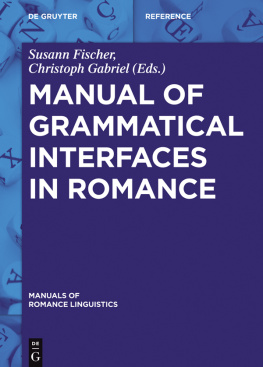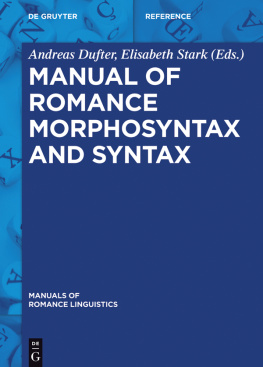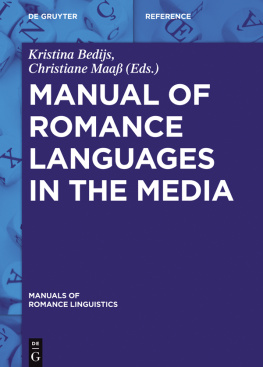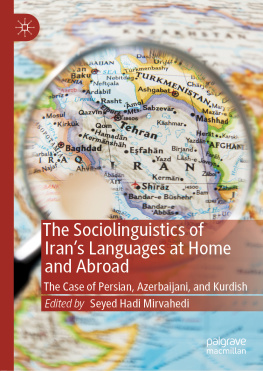Table of Contents
Guide

Manual of Romance Sociolinguistics
MRL 18
Manuals of
Romance Linguistics
Manuels de linguistique romane
Manuali di linguistica romanza
Manuales de lingstica romnica

Edited by
Gnter Holtus and Fernando Snchez Miret
Volume 18

ISBN 978-3-11-037012-6
e-ISBN (PDF) 978-3-11-036595-5
e-ISBN (EPUB) 978-3-11-039433-7
Library of Congress Control Number: 2018934550
Bibliographic information published by the Deutsche Nationalbibliothek
The Deutsche Nationalbibliothek lists this publication in the Deutsche Nationalbibliografie;
detailed bibliographic data are available on the Internet at: http://dnb.dnb.de.
2018 Walter de Gruyter GmbH, Berlin/Boston
Typesetting: jrgen ullrich typosatz, Nrdlingen
www.degruyter.com
Manuals of Romance Linguistics
The new international handbook series Manuals of Romance Linguistics ( MRL ) will offer an extensive, systematic and state-of-the-art overview of linguistic research in the entire field of present-day Romance Studies.
MRL aims to update and expand the contents of the two major reference works available to date: Lexikon der Romanistischen Linguistik ( LRL ) (19882005, vol. 18) and Romanische Sprachgeschichte ( RSG ) (20032008, vol. 13). It will also seek to integrate new research trends as well as topics that have not yet been explored systematically.
Given that a complete revision of LRL and RSG would not be feasible, at least not in a sensible timeframe, the MRL editors have opted for a modular approach that is much more flexible:
The series will include approximately 60 volumes (each comprised of approx. 400600 pages and 1530 chapters). Each volume will focus on the most central aspects of its topic in a clear and structured manner. As a series, the volumes will cover the entire field of present-day Romance Linguistics, but they can also be used individually. Given that the work on individual MRL volumes will be nowhere near as time-consuming as that on a major reference work in the style of LRL , it will be much easier to take into account even the most recent trends and developments in linguistic research.
MRL s languages of publication are French, Spanish, Italian, English and, in exceptional cases, Portuguese. Each volume will consistently be written in only one of these languages. In each case, the choice of language will depend on the specific topic. English will be used for topics that are of more general relevance beyond the field of Romance Studies (for example Manual of Language Acquisition or Manual of Romance Languages in the Media ).
The focus of each volume will be either (1) on one specific language or (2) on one specific research field. Concerning volumes of the first type, each of the Romance languages including Romance-based creoles will be discussed in a separate volume. A particularly strong focus will be placed on the smaller languages ( linguae minores ) that other reference works have not treated extensively. MRL will comprise volumes on Friulian, Corsican, Galician, Vulgar Latin, among others, as well as a Manual of Judaeo-Romance Linguistics and Philology . Volumes of the second type will be devoted to the systematic presentation of all traditional and new fields of Romance Linguistics, with the research methods of Romance Linguistics being discussed in a separate volume. Dynamic new research fields and trends will yet again be of particular interest, because although they have become increasingly important in both research and teaching, older reference works have not dealt with them at all or touched upon them only tangentially. MRL will feature volumes dedicated to research fields such as Grammatical Interfaces, Youth Language Research, Urban Varieties, Computational Linguistics, Neurolinguistics, Sign Languages or Forensic Linguistics. Each volume will offer a structured and informative, easy-to-read overview of the history of research as well as of recent research trends.
We are delighted that internationally-renowned colleagues from a variety of Romance-speaking countries and beyond have agreed to collaborate on this series and take on the editorship of individual MRL volumes. Thanks to the expertise of the volume editors responsible for the concept and structure of their volumes, as well as for the selection of suitable authors, MRL will not only summarize the current state of knowledge in Romance Linguistics, but will also present much new information and recent research results.
As a whole, the MRL series will present a panorama of the discipline that is both extensive and up-to-date, providing interesting and relevant information and useful orientation for every reader, with detailed coverage of specific topics as well as general overviews of present-day Romance Linguistics. We believe that the series will offer a fresh, innovative approach, suited to adequately map the constant advancement of our discipline.
Gnter Holtus (Lohra/Gttingen)
Fernando Snchez Miret (Salamanca)
May 2018
Acknowledgements
We would like to thank the following people who kindly offered us advice during the preparation of this volume: Adam Ledgeway, Mair Parry, Nigel Vincent and Christopher Pountain. A number of people helped with copyediting the text, bibliographical work, and translating the chapters by Manzano and Bergounioux/Jacobson/Pietrandrea: Sarah Brierley, Jessica Brown, Merryn Davies-Deacon, Daniel McAuley, Jessica Soltys, and particularly Aedn N Loingsigh. We are also grateful to the series editors, Gnter Holtus and Fernando Snchez Miret, and to the editorial team at De Gruyter, notably Gabrielle Cornefert.
Wendy Ayres-Bennett and Janice Carruthers

Introduction
Wendy Ayres-Bennett and Janice Carruthers
0Romance sociolinguistics: past, present, future
Abstract: In this chapter we consider what it means to produce a Manual of Romance Sociolinguistics. We outline the development of Sociolinguistics and situate Romance Sociolinguistics within this, highlighting in particular its distinctive characteristics. We conclude by considering possible new directions for scholars working in the field, and argue that there needs to be more truly comparative work, which draws on the wealth and diversity of the data afforded by the very many genetically related dialects, regional varieties, minoritized and major languages of the Romance-speaking area. We contend that such studies will not only contribute to general theories of variation and change and the testing of so-called sociolinguistic universals, but also address important areas of language policy, including the maintenance and support of linguistic diversity at a time of high mobility and migration, as well as concerns about the effects of globalization and the dominance of English.
Keywords: Romance sociolinguistics, sociolinguistics, recent and current trends, new directions
1Introduction
What does it mean to produce a Manual of Romance Sociolinguistics? In particular, how does this differ from a Manual of Sociolinguistics in general? To answer this question, we will start by outlining some of the main areas and issues which have dominated sociolinguistics, particularly in the anglophone world, over the last fifty years, as well as considering some of the more recent and emerging fields of interest (), we will suggest some possible new directions and fresh opportunities for scholars working in Romance sociolinguistics, whether we think of the major Romance languages or the linguae minores . This is particularly vital given the diverse sociocultural and linguistic landscape across the Romance-speaking world, and notably the changing population patterns in both urban and rural contexts. These rich and diverse data may serve not only to reinforce or further exemplify current theories and methodologies, but also to challenge assumptions and bring new questions into focus.



